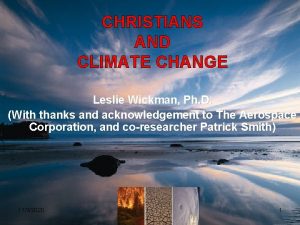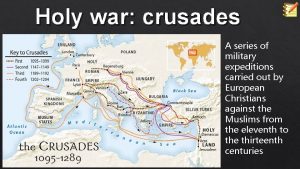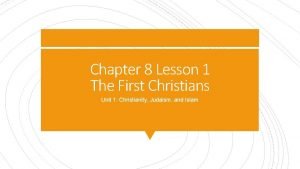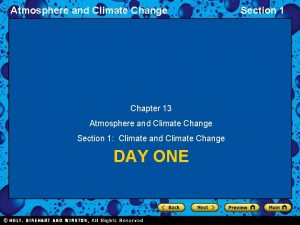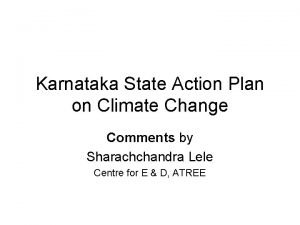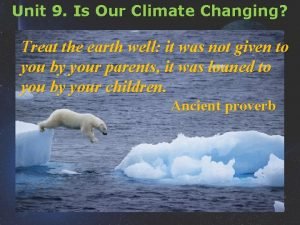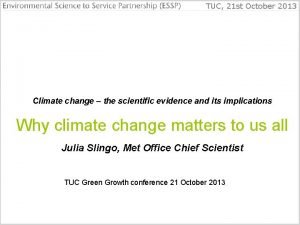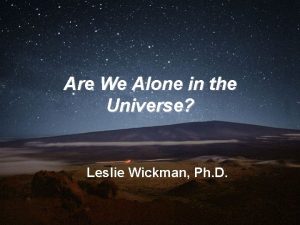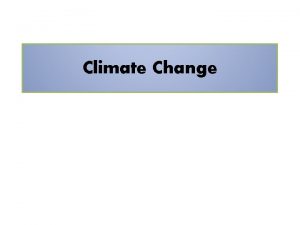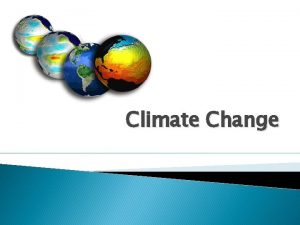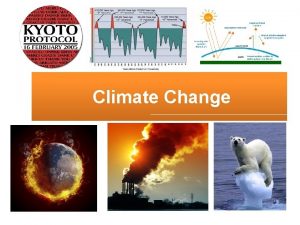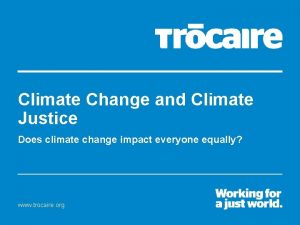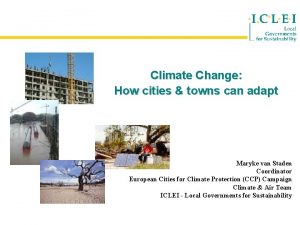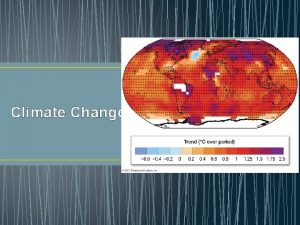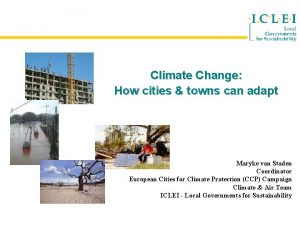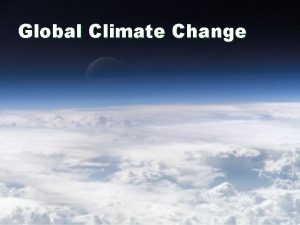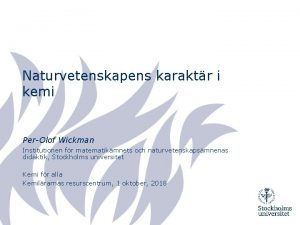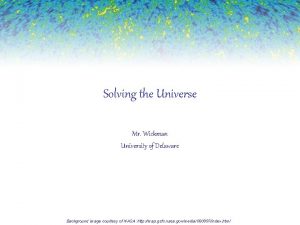CHRISTIANS AND CLIMATE CHANGE Leslie Wickman Ph D

























- Slides: 25

CHRISTIANS AND CLIMATE CHANGE Leslie Wickman, Ph. D. (With thanks and acknowledgement to The Aerospace Corporation, and co-researcher Patrick Smith) 11/9/2020 1

Introduction • “Climate change” is trending in the wrong direction for simple natural variation in earth’s weather patterns. • Earth has enjoyed a relatively stable, temperate climate for about 12, 500 years – Trends in ice-core samples and geological evidence, as well as in Milankovitch cycles show that Earth should be close to the brink of another ice age. • During the 20 th century, the increase in average global temps was ~0. 6*C, or 1*F. • 20 th century’s rate of warming was much greater than in any of the previous 9 centuries • Current rate of warming is unprecedented in at least 20, 000 years. • CO 2 in Earth’s atmosphere (currently at about 395 ppm) is higher now than at any time over the past 650, 000 -800, 000 years. • Glacial and sea ice around the world is diminishing. • The predicted effects of all these global changes are already becoming hard 2 to ignore.

An Aerospace Engineer’s Perspective on Climate Change Risk • Risk = probability x consequence – For example, a 1% risk of catastrophic loss of a launch vehicle justifies intense mitigation efforts due to cost of failure – Consequences of “losing the earth”? Infinite! • Lack of “controllability” of the atmosphere-the CO 2 decay time constant is 100 years! • Nonlinear “trip” phenomena—unpredictable and chaotic 11/9/2020 3

Climate Change & Pascal’s Wager • Risk = probability x consequence SCENARIO PROBABILITY OF CC CONSEQUENCE Presume false: Do nothing (correct “guess”) 0% (Climate Change: false) Nothing: Life goes on as usual Presume real: Act to prevent/prepare (incorrect “guess”) 0% (Climate Change: false) Spend lots of money needlessly Presume false: Do nothing (incorrect “guess”) 100% (Climate Change: real) Earth becomes uninhabitable Presume real: Act to prevent/prepare (correct “guess”) 100% (Climate Change: real) Earth remains habitable (Oregon H. S. teacher Greg Craven’s You. Tube video inspired my version of this argument. ) 4

Research Focus • Exploring the impacts of potential climate scenarios on national security issues 11/9/2020 5

Climates around the World are Changing Figure 1: Brief Summary of Evidence of Global Climate Change. From the Summary for Policymakers of the Synthesis Report of the IPCC (Intergovernmental Panel on Climate Change) Fourth Assessment Report, IPCC Plenary XXVII, 1 -23, Valencia, Spain, 2007. 11/9/2020 6

IPCC Worldwide Regions of Concern 11/9/2020 7 7

U. S. Census Bureau Climate Concerns 09 November 2020 8 8

Global Changes Projected • Gradual but significant climate change very likely – – – – Arctic ice melting Sea levels rising Rainfall is increasing overall but less predictable locally Hurricane severity increasing due to warmer oceans Drought affecting larger areas Tropical diseases moving north Fishing areas disrupted • Rapid sudden changes less likely but still possible – Positive feedbacks amplify greenhouse effect causing changes to occur sooner than current climate models predict – Possible shut down of Gulf Stream, ice age in Northern Europe 11/9/2020 9

Various Impacts are Projected Globally in this Century – – – – – decreased snowpacks increased winter floods reduced spring/summer melt-related river flows heightened competition for over-allocated water resources; initial increase in aggregate yields of rain-fed agriculture, with variability among regions; adverse effects on crops already near the warm end of their suitable temperature range, or dependent on over-allocated water resources; heatwave-prone cities are expected to be faced with an increased number, intensity & duration of heatwaves; coastal communities & habitats will be increasingly impacted by climate change effects combined with growth, development & pollution; increased spread of diseases. 13 10

Global Impacts • Climate change risks could increase political instability – A taste of the future? • • European and Asian heat waves Drought in Russia, Africa, Texas Hurricane Katrina Conflicts over water rights • Other global issues compound climate risks – Ethnic and religious conflicts, terrorism – Peaking oil production, energy blackmail – Globalization and the resentment it causes • U. S. military roles likely to increase – Peace keeping, disaster relief, border protection, treaty 11 enforcement, etc.

Increasingly Severe Weather Historical weather data that is currently used for launch availability and hazard prediction will need to be revised. Trends in Reported Natural Disasters (c) United Nations Environment Programme / GRID-Arendal. 11/9/2020 12

Costs of Extreme Weather Events UNEP 11/9/2020 Epstein 13 $150 b/yr w/in this decade

Arctic Melting • Summertime opening of Arctic would cut 7000 km/4000 nm off sea routes between Europe and Asia – Increased ship traffic, including tourism • Arctic will open up for fossil fuel exploitation ~ 40% of world’s oil and gas reserves are located in the Arctic region • Increased Arctic military activity by surrounding nations – Russia, Denmark, Norway, Canada and U. S. have all staked resource claims in the Arctic – Canada may ask for help from U. S. to patrol its Arctic coastline. • Increased need for polar satellite communications – Polar communications requirements are currently a low priority • Search & Rescue capability – 8 hours away from assistance 14

Arctic Ice Melt September 1980 September 2007 Arctic sea ice disappeared at a rate of 7. 8% per decade between 1953 and 2006—more than 3 times faster than predicted by IPCC models. --National Center for Atmospheric Research & UC Boulder joint study, May 2007 11/9/2020 15

New Polar Sea Routes 11/9/2020 ACIA 2004 16

Rising Sea Level • Coastal areas will flood causing huge refugee migrations • Saltwater infiltration will aggravate fresh water shortages • Increased military disaster relief and border policing requirements • Launch facilities at Cape threatened by storm surges 11/9/2020 17

Rising Sea Level • Coastal populations – 16 of world’s 23 largest cities – 1. 6 million Texans – 5 million in Bangladesh New Orleans, Boston Globe, 9/2005 11/9/2020 • Private & public property damage & destruction • • Climate refugees 3 to 4 feet of sea level rise puts 10 million people out of homes, and could seriously impact these bases - 3 to 4 foot rise likely by 2100; - 20 feet possible by 2100 18

Kennedy Space Center How long before launch facilities are flooded? Source: Areas subjected to Inundation with a 1 m (~3 ft) rise in sea level 11/9/2020 Miami Corell, R. W. , 2004: Impacts of a warming Arctic Climate Impact Assessment (www. acia. uaf. edu) Cambridge University Press (www. cambridge. org). 19

Increasing Drought • Increased conflicts over water rights – Water a factor in Arab vs. Israel, Egypt vs. Sudan (1958), Ethiopia vs. Somalia (1963 -64), Iraq vs. Syria (1974), and the Cochabamba (2000) conflicts – Current issues in Africa (Nile), Middle East (Tigris. Euphrates, and Jordan), Asia (Aral Sea, and Indus river system) • Population unrest and migration likely – E. g. , China currently has least fresh water person • Increased disaster relief and resettlement efforts requiring U. S. military support 11/9/2020 20

Fishing Disruption • Damage to fishing regions (already under severe stress) – Asian populations particularly dependent on fishing • Increased coastal surveillance and military actions by nations to protect fishing areas • Increased ocean surveillance requirements 21

Gulf Stream Collapse • Recent Do. D-sponsored study looked at military implications if this occurred in next 10 years – Northern Europe would become like Siberia and Equatorial regions would be too hot to sustain current populations • Indications that this might occur (some see signs already) could cause pre-emptive actions by governments in region • Treaty obligations may oblige U. S. military to assist allies in region 11/9/2020 22

The Global Ocean Conveyor FRESH WATER …shutdown during the Younger Dryas cold period 11/9/2020 23


References 1. National Security and the Threat of Climate Change, Military Advisory Board Report, The CNA Corporation, Alexandria, VA, 2007. 2. National Security Presidential Directive 66/Homeland Security Presidential Directive 25, accessed on July 13, 2009, at http: //blog. usni. org/? p=833. 3. Summary for Policymakers of the Synthesis Report of the IPCC (Intergovernmental Panel on Climate Change) Fourth Assessment Report, IPCC Plenary XXVII, 1 -23, Valencia, Spain, 2007. 4. Peduzzi, P. , "Is climate change increasing the frequency of hazardous events? " originally published in Environment Times, www. environmenttimes. net, 2004. Accessed on July 22, 2009, at http: //maps. grida. no/go/graphic/trends_in_natural_disasters. 5. “Photo in the News: Arctic Ice Melting Rapidly, Study Shows, ” National Geographic News, September 14, 2006. Accessed on July 23, 2009, at http: //news. nationalgeographic. com/news/2006/09/060914 -arctic-ice. html. 6. Shipley, D. , “Arctic Sea Ice Extent Trending Below Record 2007 Melt, ” The Daily Green, June 12, 2009. Accessed on July 13, 2009, at http: //www. thedailygreen. com/environmentalnews/latest/arctic-sea-ice-47061201. 7. Amos, J. , “Arctic summers ice-free ‘by 2013’, ” BBC News, December 12, 2007. Accessed on July 13, 2009, at http: //news. bbc. co. uk/2/hi/science/nature/7139797. stm. 8. “Global Warming Speeds Up Race for North Pole, ” Jane’s Defense Weekly, January 16, 2008. 9. Borgerson, S. , “Arctic Meltdown: The Economic and Security Implications of Global Warming, ” Foreign Affairs, March/April 2008. 11/9/2020 25
 Leslie wickman
Leslie wickman Climate change 2014 mitigation of climate change
Climate change 2014 mitigation of climate change Difference between catholic and christian
Difference between catholic and christian Number of christians in the world
Number of christians in the world How should christians dress
How should christians dress Save teachers sundays
Save teachers sundays Military expeditions carried out by european christians
Military expeditions carried out by european christians Why christians should not celebrate halloween
Why christians should not celebrate halloween When christians get it wrong
When christians get it wrong India christians laws
India christians laws Lesson 1 the first christians
Lesson 1 the first christians The disciples were first called christians
The disciples were first called christians Christians ö
Christians ö When christians get it wrong
When christians get it wrong Christians ö
Christians ö Christians values
Christians values Factors that helped spread christianity
Factors that helped spread christianity Climate change meaning
Climate change meaning Atmosphere
Atmosphere Chapter 13 atmosphere and climate change
Chapter 13 atmosphere and climate change Persuasive essay about global warming
Persuasive essay about global warming Karnataka state action plan on climate change
Karnataka state action plan on climate change Why are tropical climates so hot brainpop
Why are tropical climates so hot brainpop Unit 9 climate change
Unit 9 climate change Conclusion of climate change
Conclusion of climate change Conclusion of climate change
Conclusion of climate change
